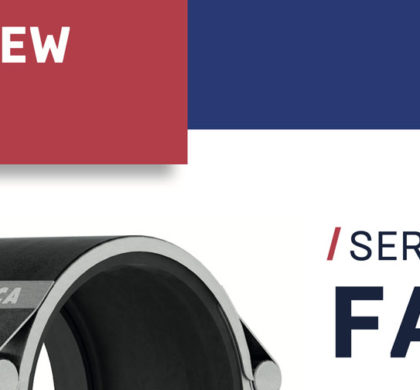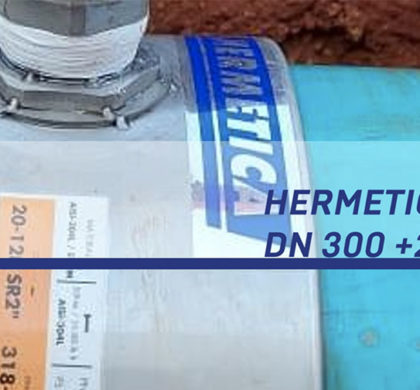Waffle gasket repair clamps or PASSIVE SEAL repair clamps. A definitve solution for pipe leak maintenance?

Flat gasket repair clamps are considered as a repair product to fix pipes no matter what the repair situation is, apparently there seems to be no repair that a PASSIVE SEAL clamp can’t fix… but is this true?
Does a pipe have a hole or a crack? do the pipes need to be joined? is there a shear break?
The quick (and dangerous) answer may be yes, a PASSIVE SEAL clamp can do the job. But if we study the application in detail there may be other solutions with better performance.
Today we want to discuss when it may be appropriate to use flat seal repair clamps also known as PASSIVE SEAL clamps and how to use and install them correctly, as well as why their use should be avoided in certain applications.
First of all let’s review the technology of PASSIVE SEAL flat joint clamps and their limitations.
PASSIVE SEAL clamps use a single waffle type gasket with bevelled ends. The gasket, glued to the inside of the clamp, overlaps at its end onto itself along the entire length of the clamp to generate a seal around the entire circumference.
To function properly, PASSIVE SEAL repair clamps require the application of internal and external loads. The installers provide this load by tightening the hardware, and the opposite internal load is provided by the pipe wall itself.
Limitations of PASSIVE SEAL clamps
To begin with, it should be made clear that the mechanical loads applied to the fasteners may exceed the mechanical strength of the elastomer itself, compromising its performance in the medium and long term. For this reason, it is always recommended to select clamps with the lowest tightening torque available on the market and to use a torque control spanner [torque wrench or torque spanner].
On the other hand, the overlap locking system of the clamp requires that there is a continuous pipe surface to provide a load along the overlap area, otherwise the internal beveled part will not find that internal load sufficient and will create an exit point for the start of water leakage.
Of course it must be clarified that because the seal is generated by pure compression on the face of the pipe, this clamp does not adapt to changes in the environment that will be generated over time, whether external loads, pressure fluctuations, temperature changes … hence its name PASSIVE.
The PASSIVE SEAL clamp can be an effective basic product when used correctly for a specific number of applications.
Some of the applications listed in catalogues for these PASSIVE SEAL repair clamps are the coupling of smooth pipe ends, the joining of deviated or misaligned pipes, as well as the repair of shear breaks, longitudinal cracks, holes or pitting. Unfortunately, clamps are often used in applications that go beyond their limits.
Many see the PASSIVE SEAL repair clamp as a temporary and inexpensive solution to serious pipe breaks, so recurring replacement of repair clamps is commonplace. Others see no problem with using repair clamps regardless of the problem to be solved and believe that, as they have always done so, it is fine. However, a failure leads to recurring pipe damage, water loss and increased economic and environmental costs.
Repairing longitudinal cracks, holes and pitting
Cracks, holes and pitting can be repaired with a PASSIVE SEAL clamp if proper precautions are taken and the capacity of this product is taken into account.
The 150 mm (or 6″) rule is extended to determine the proper length of the PASSIVE SEAL clamp.
Use PASSIVE SEAL repair clamps that are at least 150 mm longer than the problem to be repaired (crack, puncture or pitted area), taking care to position the bevelled section of the joint on the side of the pipe opposite the leak.
If the clamp is installed with the bevelled section over the leak, the clamp may leak. It may not happen immediately, but with slight soil movement, temperature or other changes in conditions, the beveled section will open and water will leak out. This is one of the limitations of PASSIVE SEAL clamps with flat waffle joints.
Everyone, from the installer to the pipeline design engineer, should be aware of the capabilities of PASVIO SEALING clamps.
Repairing shear breaks
The capacity of PASSIVE SEAL repair clamps is often overestimated.
Shear breaks are often caused by ground movements or other bending forces exerted on the pipe. Repairing shear breaks by clamping may work with the initial installation, as the pipe is still restrained. However, when these external forces continue after installation of the PASSIVE SEAL repair clamp, this will cause the two sections of pipe to separate, breaking the thin waffle joint of the clamp, which, due to its PASSIVE technology has no ability to recover and adapt, resulting in a new leak.
Connection of aligned and misaligned pipe ends
These practices occur when the functionality of the PASSIVE SEAL clamps is pushed beyond its limit.
As with shear breaks, PASSIVE SEAL repair clamps are never the right solution for these breaks, and will not last. They simply cannot adapt (PASSIVE SEAL) to the pipe influenced by external forces and the clamp will eventually give way and generate the leak.
In summary
Inflated expectations of how PASSIVE SEAL clamps can repair pipes have led to them being used in ways that were not originally intended. It can be tempting to use PASSIVE SEAL clamps to repair all kinds of breaks, given their relatively low price.
While PASSIVE SEAL repair clamps may be suitable for repairing cracks, holes and pitting, use for repairing shear breaks and plain end coupling will not last in the short term.
In our next article we will propose definitive solutions for all these situations. We are constantly working on getting the industry to recognise that suitable and permanent solutions exist, with the aim of adopting these practices for their routine maintenance operations.
Post en LinkedInwww.hermeticasf.com | info@hermeticasf.com









